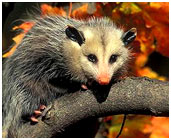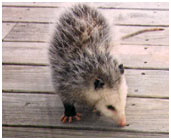Opossum is a small marsupial found in major parts of the world. Learn some interesting facts and amazing information about Opossum.
Facts About Opossum
Opossums are quite often referred as ‘the living fossil’, as they have been residing on earth since the dinosaur age. They have been known to inhabit the earth since the past 70-80 million years, making them one of the world’s oldest surviving mammals. Existing in various sizes and weights, opossums have white face, hairy grey body, naked ears and a scaly tail. Though they do look like rats, they are not at all related with them. Rather, they can be similar to cats, in a way that they are extremely clean and groom themselves often. Often called possums, they are extremely versatile animals. They are efficient swimmers, climbers and also extremely adaptable. They eat a variety of foods and reproduce rapidly. Opossums are also solitary and nocturnal animals. They like to stay in dark and secured areas. Because they are nomadic, opossums do not put much effort in digging holes to build their house, rather, they search for abandoned burrows for a temporary stay. To know some more interesting facts and amazing information on opossums, read on. 

Fast Facts
Kingdom: Animalia
Phylum: Chordata
Class: Mammalia
Order: Didelphimorphia
Family: Didelphidae
Infraclass: Marsupialia
Species: More than 60
Length: 2.5 ft (length from nose to tail)
Weight: 4-6 kg
Teeth: 50
Diet: Omnivorous
Natural Habitat: United States, South & North America, Australia
Life Span: 2 to 4 years
Call: Adult: Smack noise; Young Ones: Sneezing or hissing
Gestation Period: 12 to 14 days
Number of Offspring: As many as 20 litters (depending upon species)
Interesting & Fun Facts About Opossums
- More than 60 different species of opossum live on the earth. The most-widely found opossum is the Virgina opossum, which forms the only pouched mammal in Canada and the United States.
- Opossum is resistant to diseases like rabies, because of its efficient immune system and low body temperature.
- The babies of opossum are as small as honeybees. They develop in the pouch of their mother. Sometimes, they even ride on their mother’s back, as it goes hunting for food.
- Opossum is an excellent tree climber and uses its sharp claws, tail and mouth for serving this purpose.
- It lives in the holes of the trees. In some cases, it also finds its shelter in the dens of other animals.
- Opossum has neither good eyesight nor strong hearing power. However, it has a sharp sense of smell, which guides in its food-hunting venture.
- The mammal is nocturnal and hides during the day. It exhibits the traits of a scavenger and visits human homes to find its food from garbage and other containers.
- When threatened, opossum curls up in the shape of a coma and become motionless. It sometimes flops on its sides and remains lying on the ground, with its eyes closed or fixed in one direction. It can remain in this state from 1 minute to 6 hours.
- Opossum has a robust immune system and is resistant to snake venom. It is known to be non-aggressive in character and always keeps itself extremely clean.
- It usually stays alone and is nomadic. It sticks on to one place as long as it gets sufficient food in the place.
- Male opossum makes smack noise to attract the female counterparts, whereas the female sometimes repeats the same sound. Baby opossum makes sneezing or hissing sound, when it faces a danger or is distressed.
- Before giving birth, an opossum mother vigorously licks and cleans the pouch for the newborns. She also cleans the path in which the babies shall crawl into the pouch.
- It was Captain John Smith who used the term opossum for the first time in 1608. The name was adapted from the Native American Algonquin term ‘apasum’, which mean white animal.
- Opossums have 50 teeth which is more than any mammal.
- Since opossums have not evolved much since their origin, their brain in relatively primitive and smaller than a placental mammal of the same size.
- The female opossum has a vagina divided uterus and the male has a forked penis.
- Opossums give birth to two litters per year, each have an average number 8 babies. It takes at least 67 day for them to crawl out of the pouch and 75 days to have solid food.


See also
More from iloveindia.com
- Home Remedies | Ayurveda | Vastu | Yoga | Feng Shui | Tattoos | Fitness | Garden | Nutrition | Parenting | Bikes | Cars | Baby Care | Indian Weddings | Festivals | Party ideas | Horoscope 2015 | Pets | Finance | Figures of Speech | Hotels in India : Delhi | Hyderabad | Chennai | Mumbai | Kolkata | Bangalore | Ahmedabad | Jaipur
- Contact Us Careers Disclaimer Privacy Policy Advertise With Us Lifestyle Sitemap Copyright iloveindia.com. All Rights Reserved.



